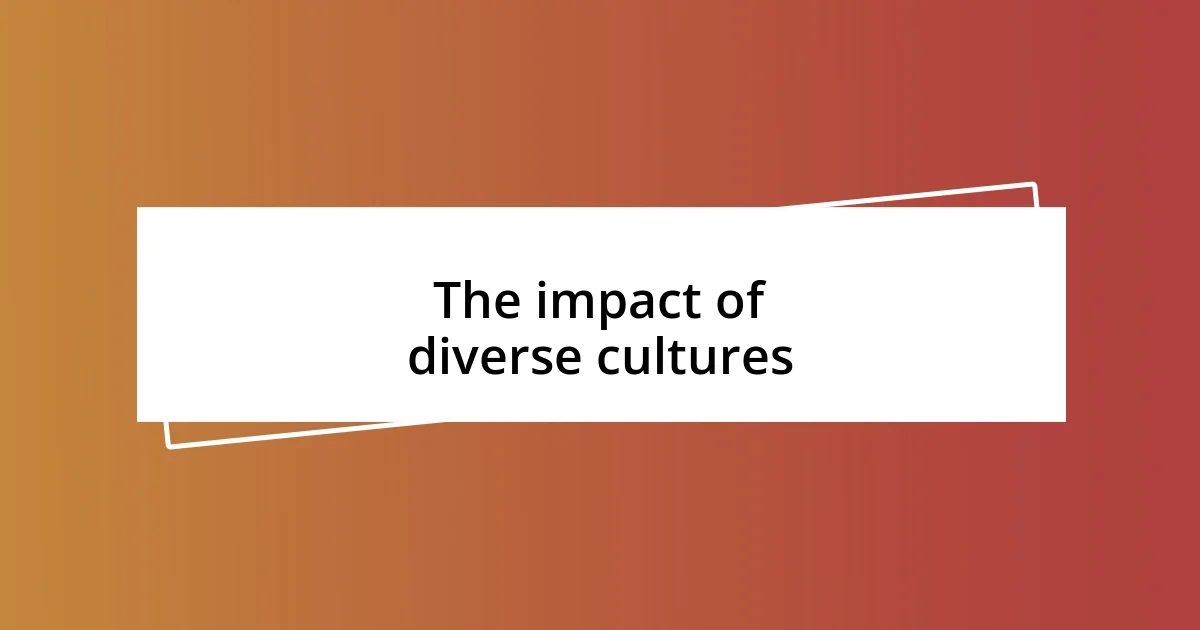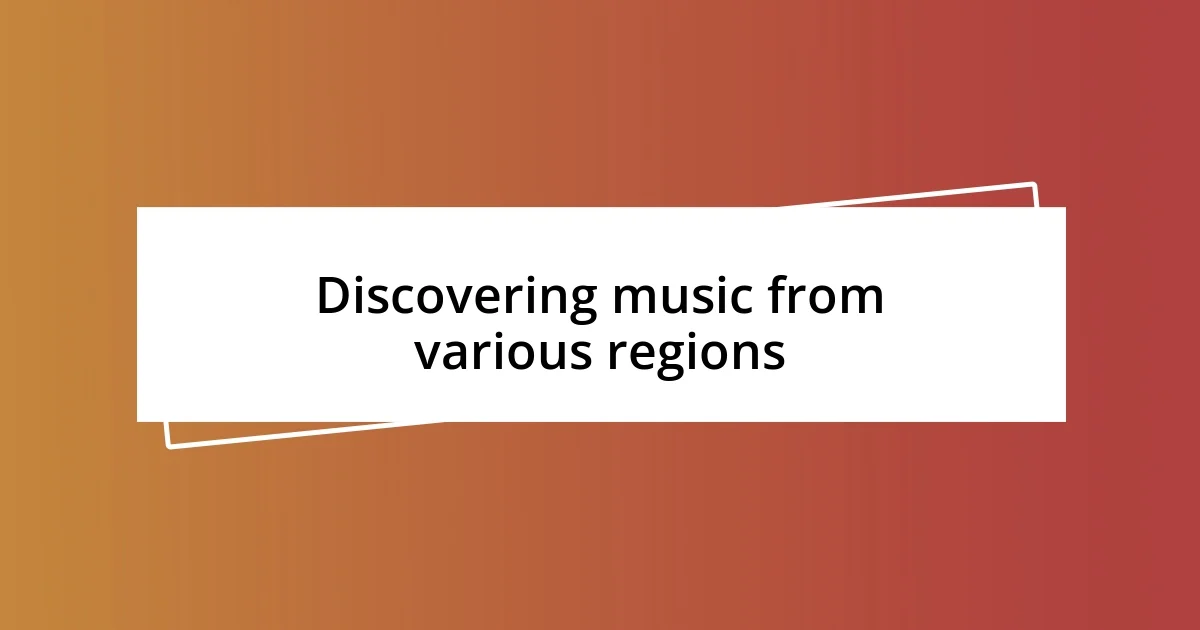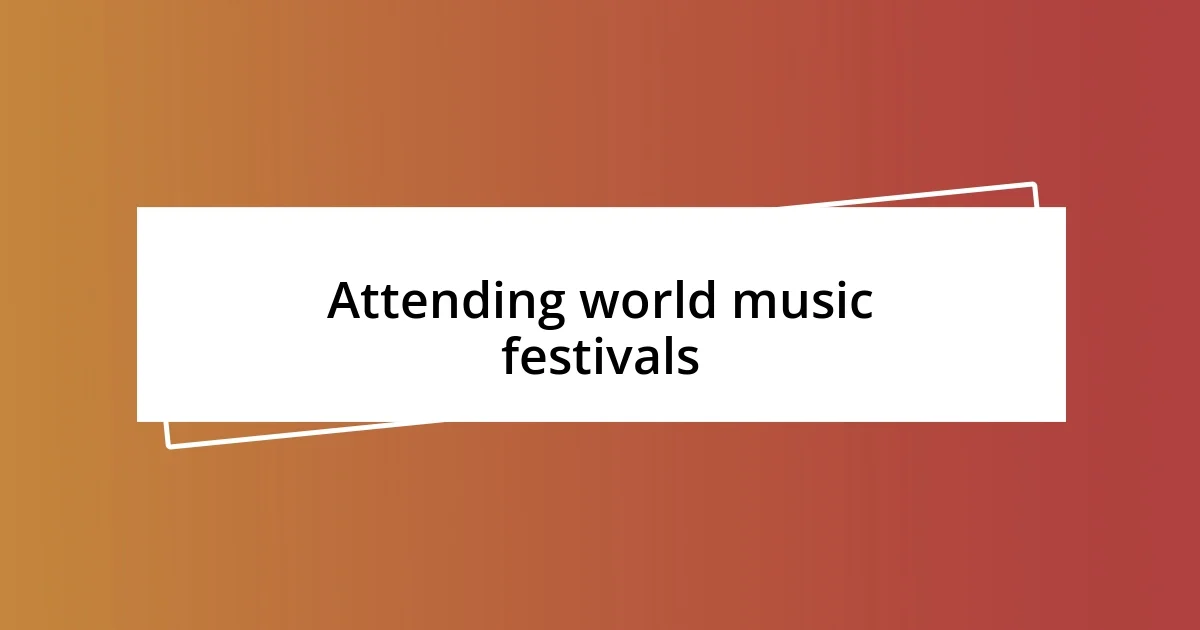Key takeaways:
- The author’s love for world music began with Fela Kuti’s “Lady,” leading to a deeper appreciation for diverse cultural sounds.
- Experiences at world music festivals highlighted the unifying power of music, demonstrating how it can create connections across different backgrounds and cultures.
- Building a world music playlist becomes a journey of exploration and personal growth, with each song representing a unique story and cultural insight.

My introduction to world music
I remember the first time I heard Fela Kuti’s “Lady.” The infectious Afrobeat rhythm grabbed my attention and made my heart race. How could one song evoke such energy and joy? It was a turning point that opened my ears to a world of diverse sounds.
Around that time, I stumbled upon a local world music festival. The vibrant colors and different melodies drew me in, and I found myself completely captivated by the music of various cultures. Each performance felt like a window into someone else’s life, and I couldn’t help but wonder how music could unite beings across continents.
As I dived deeper into these genres, I felt a sense of connection that went beyond words. Listening to traditional Andean flutes or the intricate rhythms of Indian classical music was like sharing a conversation with distant friends. Have you ever felt that rush of emotion when a piece of music resonates with your soul? That’s how I knew I was falling in love with world music.

The impact of diverse cultures
The beauty of world music emerges from the intricate tapestries woven by diverse cultures. Each note tells a story, reflecting traditions, struggles, and joys. I remember hearing a haunting ballad from a Syrian musician; it felt like a conversation through time, expressing sorrow and hope that transcended language. That experience made me realize how vital cultural exchanges are—music can bridge gaps and foster empathy between us.
Participating in a Malaysian drum circle was another transformative moment for me. The rhythm moved through the group, uniting us in a pulsating heartbeat of sound. As I played beside individuals from various backgrounds, I felt a sense of kinship and understanding, reminding me that our differences are what make us beautiful. Isn’t it amazing how music can lead to connections that might otherwise never happen?
When I discovered a traditional Japanese shamisen performance, I was struck by how its melodies conveyed emotion without words. It’s these moments that highlight how diverse cultural expressions can serve as a universal language. Reflecting on these experiences, I see how music not only showcases cultural heritage but also encourages us to embrace our global community.
| Cultural Aspects | Musical Elements |
|---|---|
| Malaysian Drumming | Rhythmic unity among diverse participants |
| Andean Flutes | Melodic expressions of connection and tradition |
| Syrian Ballads | Emotionally rich storytelling |
| Japanese Shamisen | Melody conveying deep emotions |

Discovering music from various regions
As I explored the sounds of different regions, I found myself drawn to the vibrant rhythms of Brazilian samba. The first time I danced to it, I felt an electric joy surging through me, making me forget everything else. Each beat seemed to invite me into a celebration of life. Traveling to Brazil, I took part in a local carnival, and the way the music enveloped the streets was nothing short of enchanting.
- Brazilian samba: A celebration of joy and life’s vibrancy.
- Afrobeat from Nigeria: A blend of traditional African sounds with jazz influences.
- Indian classical music: The intricate ragas that evoke deep emotions and connect listeners to history.
- Celtic folk tunes: Melodies that tell tales of love, loss, and adventure, reminding me of storytelling traditions.
- Middle Eastern zaar drum circles: The rhythm is almost hypnotic, drawing everyone into a communal experience.
Each discovery felt like peeling back layers of human expression. I remember listening to a captivating rendition of a Tuareg guitar piece, which painted a vivid picture of the deserts of Mali. It made me contemplate the vastness of life experiences and how music can encapsulate feelings of longing and hope. It’s fascinating how these melodies, rooted in different histories, speak to a universal human experience.

Key instruments in world music
Experiencing the sound of the Andean pan flute for the first time felt like a gentle breeze sweeping through the peaks of the mountains. I can still remember the way those high, airy notes danced around me, each one weaving a narrative of the Andean landscape. It’s fascinating how a simple set of bamboo pipes can transport listeners to a world steeped in tradition and spirituality, connecting us to the essence of nature.
Then there’s the djembe, a goblet drum from West Africa that I encountered during a community workshop. With every beat, it resonated deep within my chest, almost like a heartbeat shared among us. It was electrifying to see how everyone around me, regardless of their background, instinctively found their rhythm, creating a vibrant tapestry of sound. Have you ever felt that primal connection with a musical instrument? It’s as if the djembe spoke a language understood by all, harmonizing our voices into one profound expression.
Lastly, my encounter with the sitar during a personal retreat in India remains etched in my memory. As the strings were plucked, the room pulsed with melodies that ebbed and flowed, evoking joy and introspection alike. I found myself closing my eyes, letting the intricate ragas guide me on a journey through time and emotion. It really struck me how world instruments don’t just create music; they tell stories, convey feelings, and encapsulate whole cultures in each resonant note. Have you discovered an instrument that made you feel this deeply connected to another culture? That magical moment is something I cherish.

How lyrics connect people
Lyrics have an extraordinary power to bridge cultural divides. I remember sitting in a tiny café in Paris, listening to a singer belt out a heartfelt chanson. Though I didn’t understand every word, the emotion behind the lyrics was palpable. It resonated with my own experiences of love and loss, reminding me of how words can transcend language barriers and create a shared understanding among people from different walks of life. Have you ever felt that connection with a song, even when the lyrics were in a language you didn’t know?
In my journey through various music genres, I’ve often found that lyrics can tell stories that can be both deeply personal and universally relatable. The first time I heard a reggae track about struggle and resilience, I was surprised at how quickly it resonated with my own challenges. The artist’s raw vulnerability made me feel connected to a community I’d never even met before. It’s incredible how a few well-chosen words can weave a collective experience, turning solitary feelings into shared narratives.
I also think about how songs sung in Spanish during summer gatherings instantly envelop me in warmth and nostalgia. I recall dancing with friends to a lively cumbia, the lyrics celebrating life and togetherness. Even though I didn’t grasp every phrase, the upbeat energy was infectious, and we were united in joy. In these moments, I realized that the essence of connection lies in recognizing our common humanity, all sparked by the evocative power of lyrics. How often has music aligned with your joys and struggles, making you feel part of something bigger?

Attending world music festivals
Attending world music festivals opened my eyes and ears to a kaleidoscope of cultures. The first time I stood in a crowd at a global music festival, I was enveloped in a mosaic of sounds, scents, and smiles. I can recall the moment I danced in unison with strangers, united by the rhythm of a pulsating band from Ghana. The energy was electric, and I felt as if I was part of something greater than myself, a global family celebrating life through music.
Each festival teaches you something new about the world and the power of human connection. I’ll never forget stumbling upon a Brazilian samba ensemble that ignited the crowd into a lively dance. I remember looking around and seeing people from all walks of life, laughing, clapping, and swaying together, lost in the sheer joy of the music. Have you ever felt that contagious joy in a crowd? It’s one of those experiences where the divide between us shrinks, and you realize that happiness knows no language or border.
What truly amazed me was the diversity of traditions showcased at these festivals. When I attended a festival dedicated solely to Indian classical music, I was transported into a world of intricate ragas and soulful performances, captivating my heart and mind. I had a moment of revelation, sitting under the stars as musicians spun tales of their heritage with each note. It made me wonder: how many stories remain untold in the music we hear every day? Those moments at world music festivals have forever transformed my understanding of creativity, making me appreciate the rich tapestry of human expression that exists across the globe.

Building a world music playlist
Building a world music playlist can be a thrilling adventure in itself. I recall the day I decided to curate my first playlist, combining sounds from different continents. As I sifted through tracks ranging from the soothing sitar of India to the rhythmic beats of Afrobeat, I felt an undeniable excitement at how each song told a story of its own. Do you remember the joy of exploring new sounds and the anticipation of pressing play for the first time?
One evening, I found myself lost in the nuances of a flamenco guitar solo that ignited my soul. It was as if the artist poured out their heart into each strum, painting vivid imagery of passion and tradition. That moment made me realize that choosing songs for my playlist is not just about variety but also about connection—I want every track to evoke emotion or transport me to another place. Have you ever felt like a song was meant just for you, wrapping you in its warmth?
To give my playlist depth, I often include songs that may seem unconventional or unfamiliar. I once stumbled upon a hauntingly beautiful Balkan folk tune that, while catchy, also made me curious about the culture it came from. That single song led me down a rabbit hole of exploration, where I learned about different instruments, history, and dance styles unique to the region. It’s a reminder that each track in our playlists has the potential to open doors to new perspectives. Isn’t it fascinating to think how a simple selection of songs can lead to personal growth and exploration?














